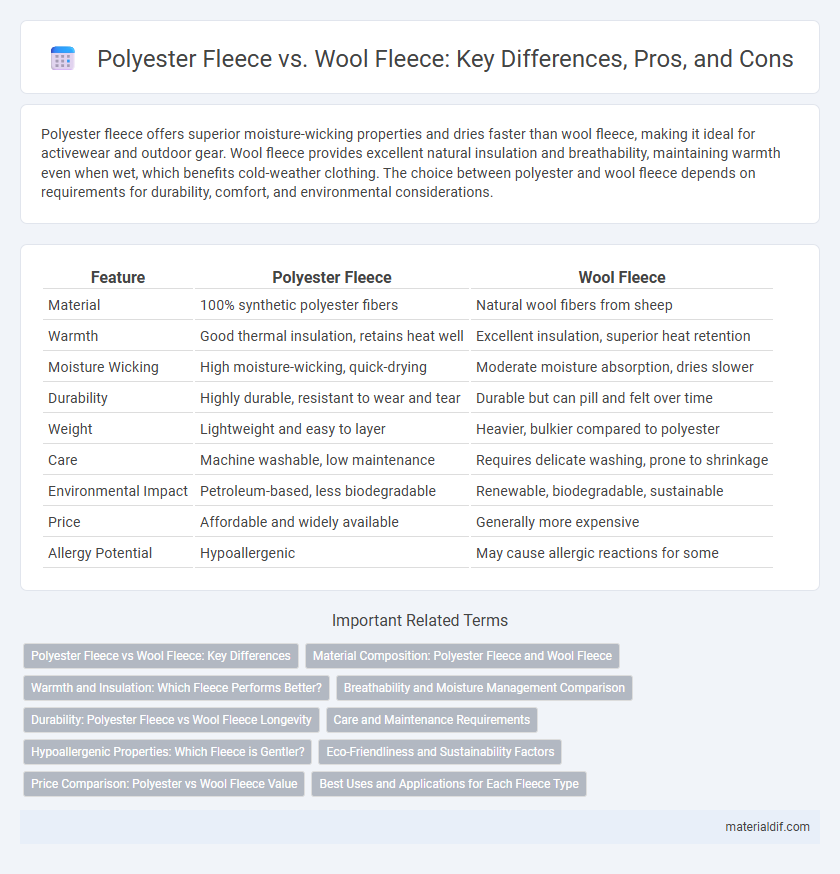Polyester fleece offers superior moisture-wicking properties and dries faster than wool fleece, making it ideal for activewear and outdoor gear. Wool fleece provides excellent natural insulation and breathability, maintaining warmth even when wet, which benefits cold-weather clothing. The choice between polyester and wool fleece depends on requirements for durability, comfort, and environmental considerations.
Table of Comparison
| Feature | Polyester Fleece | Wool Fleece |
|---|---|---|
| Material | 100% synthetic polyester fibers | Natural wool fibers from sheep |
| Warmth | Good thermal insulation, retains heat well | Excellent insulation, superior heat retention |
| Moisture Wicking | High moisture-wicking, quick-drying | Moderate moisture absorption, dries slower |
| Durability | Highly durable, resistant to wear and tear | Durable but can pill and felt over time |
| Weight | Lightweight and easy to layer | Heavier, bulkier compared to polyester |
| Care | Machine washable, low maintenance | Requires delicate washing, prone to shrinkage |
| Environmental Impact | Petroleum-based, less biodegradable | Renewable, biodegradable, sustainable |
| Price | Affordable and widely available | Generally more expensive |
| Allergy Potential | Hypoallergenic | May cause allergic reactions for some |
Polyester Fleece vs Wool Fleece: Key Differences
Polyester fleece offers superior moisture-wicking and quick-drying properties compared to wool fleece, making it ideal for active wear and outdoor activities. Wool fleece provides better natural insulation and breathability, maintaining warmth even when wet, which benefits cold-weather conditions. Unlike wool, polyester fleece is generally more durable, lightweight, and easier to care for, with less risk of allergies or irritation.
Material Composition: Polyester Fleece and Wool Fleece
Polyester fleece consists primarily of synthetic polymer fibers derived from petrochemicals, offering lightweight, moisture-wicking, and quick-drying properties ideal for activewear and outdoor gear. Wool fleece is made from natural animal fibers, predominantly sheep's wool, providing superior insulation, breathability, and moisture absorption, which contributes to warmth and comfort in colder conditions. The intrinsic durability and hypoallergenic qualities of polyester fleece contrast with the breathable, biodegradable nature of wool fleece, influencing their performance and environmental impact.
Warmth and Insulation: Which Fleece Performs Better?
Polyester fleece offers excellent warmth and moisture-wicking properties, making it highly effective for insulation in damp conditions, while wool fleece provides superior natural thermal regulation and breathability, ensuring consistent warmth even when wet. Wool fibers trap air more efficiently, resulting in better heat retention and odor resistance compared to synthetic polyester fleece. Choosing between the two depends on activity level and environment, with wool preferred for cold, humid climates and polyester excelling in wet or high-moisture settings.
Breathability and Moisture Management Comparison
Polyester fleece excels in moisture wicking and quick drying, making it highly breathable and ideal for active wear where sweat management is crucial. Wool fleece, particularly merino wool, offers natural breathability with superior temperature regulation and moisture absorption, keeping the skin dry and warm even in damp conditions. While polyester fleece is lightweight and dries faster, wool fleece provides enhanced odor resistance and maintains insulation when wet, crucial for cold-weather outdoor activities.
Durability: Polyester Fleece vs Wool Fleece Longevity
Polyester fleece demonstrates superior durability compared to wool fleece due to its synthetic fibers that resist wear, tearing, and moisture damage over time. Wool fleece, while naturally insulating and breathable, tends to degrade faster with repeated washing and exposure to harsh elements. For longevity and maintaining structural integrity in outdoor or active use, polyester fleece is generally the more resilient choice.
Care and Maintenance Requirements
Polyester fleece requires minimal care, offering easy machine washing and quick drying without risk of shrinking or moth damage. Wool fleece demands more delicate handling, necessitating hand washing or gentle cycles with wool-safe detergents and air drying to prevent felting and shrinkage. Choosing between polyester and wool fleece often hinges on maintenance preferences and durability needs.
Hypoallergenic Properties: Which Fleece is Gentler?
Polyester fleece is generally considered more hypoallergenic than wool fleece due to its synthetic fibers, which are less likely to cause allergic reactions or irritation for sensitive skin. Wool fleece can contain lanolin and other natural oils that may trigger allergies or itchiness in some individuals. For those prioritizing gentleness and minimizing allergic responses, polyester fleece offers a more suitable option.
Eco-Friendliness and Sustainability Factors
Polyester fleece, made from synthetic polymers derived from petrochemicals, has lower biodegradability and contributes to microplastic pollution, raising concerns about its eco-friendliness. Wool fleece, sourced from sheep, is a renewable and biodegradable natural fiber with a smaller environmental footprint due to its renewable agricultural origins and carbon sequestration properties. However, the sustainability of wool depends on responsible farming practices, while recycled polyester options can improve polyester fleece's environmental impact.
Price Comparison: Polyester vs Wool Fleece Value
Polyester fleece offers a significantly lower price point compared to wool fleece, making it a budget-friendly option for warmth and comfort. Wool fleece, while more expensive, provides superior insulation and natural moisture-wicking properties that justify its higher cost. Consumers seeking cost-effective fleece often choose polyester, whereas those prioritizing durability and eco-friendliness may opt for wool despite the price difference.
Best Uses and Applications for Each Fleece Type
Polyester fleece excels in moisture-wicking and quick-drying properties, making it ideal for activewear, outdoor apparel, and lightweight layering in humid or wet conditions. Wool fleece offers superior insulation and breathability, making it the top choice for cold-weather garments, thermal layers, and outdoor activities in chilly climates. Both fabrics provide warmth, but polyester fleece suits high-movement, moisture-prone environments, whereas wool fleece is preferred for durability and natural odor resistance in prolonged outdoor use.
Polyester Fleece vs Wool Fleece Infographic

 materialdif.com
materialdif.com